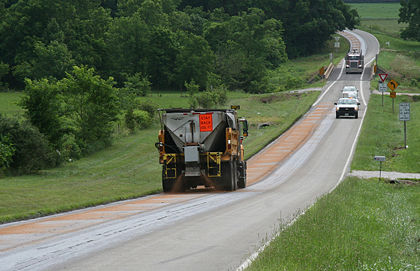413.4 Bituminous Fog Sealing: Difference between revisions
m minor clarification |
m →Maintenance Fog Sealing: terminology |
||
| (2 intermediate revisions by one other user not shown) | |||
| Line 1: | Line 1: | ||
==Material Inspection for [http://modot. | ==Material Inspection for [http://www.modot.org/business/standards_and_specs/SpecbookEPG.pdf#page=7 Sec 413.10]== | ||
Asphalt Binder for use in fog sealing shall be inspected in accordance with [[:Category:1015 Bituminous Material|EPG 1015 Bituminous Material]]. | Asphalt Binder for use in fog sealing shall be inspected in accordance with [[:Category:1015 Bituminous Material|EPG 1015 Bituminous Material]]. | ||
[[image:413.4.jpg|right|420px]] | |||
[[413.1 Micro-Surfacing#District Procedure|District procedures]] are identical to those in micro-surfacing. | [[413.1 Micro-Surfacing#District Procedure|District procedures]] are identical to those in micro-surfacing. | ||
| Line 14: | Line 14: | ||
The surface condition or texture, dryness and degree of cracking of the pavement will determine the quantity required, but the normal application rate of a 50/50 diluted material is 0.10 to 0.15 gal/sq. yd. The fog seal should be allowed to completely cure before traffic is permitted on the surface to prevent pickup by vehicle tires. The surface must be porous enough to absorb the emulsion. Sand can be used to blot wet spots. | The surface condition or texture, dryness and degree of cracking of the pavement will determine the quantity required, but the normal application rate of a 50/50 diluted material is 0.10 to 0.15 gal/sq. yd. The fog seal should be allowed to completely cure before traffic is permitted on the surface to prevent pickup by vehicle tires. The surface must be porous enough to absorb the emulsion. Sand can be used to blot wet spots. | ||
Fog seals may be used on asphalt shoulders and on cold-mix roadways only. Because of the time required for the slow-setting emulsion to break, and because of the potential for reduced surface friction immediately after seal application fog seals are not recommended for high-speed roadway pavements constructed with dense braded mixes. A | Fog seals may be used on asphalt shoulders and on cold-mix roadways only. Because of the time required for the slow-setting emulsion to break, and because of the potential for reduced surface friction immediately after seal application fog seals are not recommended for high-speed roadway pavements constructed with dense braded mixes. A fog seal may be used to add additional asphalt to a seal coat and as a dust control agent on a seal coat. The best conditions under which to apply a fog seal is a warm sunny day with low humidity. | ||
[[Category:413 Surface Treatments and Preventive Maintenance|413.04]] | [[Category:413 Surface Treatments and Preventive Maintenance|413.04]] | ||
Latest revision as of 16:49, 6 March 2024
Material Inspection for Sec 413.10
Asphalt Binder for use in fog sealing shall be inspected in accordance with EPG 1015 Bituminous Material.

District procedures are identical to those in micro-surfacing.
Laboratory Procedures
No additional laboratory procedures in this article.
Maintenance Fog Sealing
A fog seal is a light application of diluted slow-setting emulsion sprayed on an existing asphalt surface without an aggregate cover. The emulsion can be diluted up to one part emulsion to five parts water (1:5) but in most cases, a one to one dilution is used. The asphalt emulsion normally used is a SS-1, SS-1h, CSS-1, and CSS-1h.
Fog seals are used to renew old asphalt surfaces that have become dry and brittle with age and to seal very small cracks and surface voids. It also coats aggregate particles at the surface.
The surface condition or texture, dryness and degree of cracking of the pavement will determine the quantity required, but the normal application rate of a 50/50 diluted material is 0.10 to 0.15 gal/sq. yd. The fog seal should be allowed to completely cure before traffic is permitted on the surface to prevent pickup by vehicle tires. The surface must be porous enough to absorb the emulsion. Sand can be used to blot wet spots.
Fog seals may be used on asphalt shoulders and on cold-mix roadways only. Because of the time required for the slow-setting emulsion to break, and because of the potential for reduced surface friction immediately after seal application fog seals are not recommended for high-speed roadway pavements constructed with dense braded mixes. A fog seal may be used to add additional asphalt to a seal coat and as a dust control agent on a seal coat. The best conditions under which to apply a fog seal is a warm sunny day with low humidity.